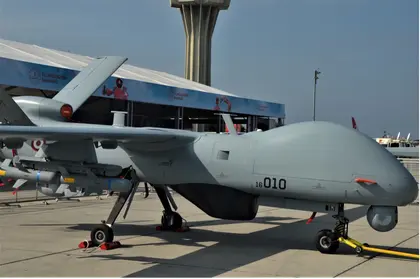Sources from Ukraine’s Military Intelligence Directorate (HUR) confirmed to Kyiv Post on Tuesday that its unmanned aerial vehicles (UAV), drones, had targeted a Shahed kamikaze drone assembly facility in Yelabuga and an oil refinery in Nizhnekamsk, both in Tatarstan, more than 1,200 kilometers (745 miles) from Ukraine.
By Tuesday afternoon many in Russia were voicing the opinion that Ukraine lacked the technical ability to launch an attack over such a distance. This despite the frequent announcements by Ukraine’s President Volodymyr Zelensky and the Minister of Digital Transformation, Mikhail Fedorov that Ukraine has built drones capable of flying in excess of 1,000 kilometers.
That skepticism was summed up by Lt.-Gen. Andrei Gurulev, a member of the Russian Duma’s defense committee in a post on his Telegram channel, who seemed convinced that Ukraine could have only done it with help from elsewhere.
JOIN US ON TELEGRAM
Follow our coverage of the war on the @Kyivpost_official.
Gurulev said: “We need to understand where they launched [the drones] from. It is not a fact that they were launched from the territory of Ukraine. But in order not to guess, our specialists need to determine the take-off point and flight path of the UAV.”
He went on to suggest who he suspected of involvement: “We have the republics of Central Asia, which are quite possible, especially those areas that are located in the northwestern side.”
Without actually naming which country he thought was responsible, the closest country that fits Gurelev’s description is Kazakhstan. His other comments indicated that was where he was looking. He said that the attack could have been organized from sparsely populated areas not controlled in any way. “Those steppe areas that are located in the northern and northwestern side are practically deserted… They are not controlled either from the air or by radar stations. Anything can be done.”

Ukraine Modifies Domestic UAV Into FPV Strike Drone ‘Aircraft Carrier’
Another quick to point the finger at Astana on his Telegram channel was Dmitry Smirnov, a Kremlin pool journalist, who pointed out that the distance to Nizhnekamsk and Yelabuga from the Kazakh border was 500 kilometers, less than half the distance from Ukraine. He later deleted the post.
Kazakhstan itself was quick to catch on to Gurulev and Smirnov’s insinuations. The Kazakh Ministry of Defense issued a strong denial on its official website on Wednesday morning. It said that Kazakhstan has nothing to do with the attacks on Russian enterprises in Nizhnekamsk and Yelabuga.
“The information disseminated in some telegram channels that the drones that allegedly attacked the objects of the Republic of Tatarstan were launched from the territory of Kazakhstan is not true,” the department said. “Such insinuations are aimed at discrediting the Republic of Kazakhstan.”
The Russian view may have also been influenced by Kazakhstan’s attempts to develop its own drone industry, which the Ministry of Science said were needed to detect emergency situations, to monitor powerlines, oil and gas pipelines, to combat poaching, to count animals, to control the state border, and to monitor the condition of agricultural lands.
In October, Turkish Aerospace Industries (TAI) announced that a partnership was being formed between TAI and Kazakhstan Engineering to build the “Anka” medium-altitude long-endurance (MALE) UAV in Kazakhstan starting in 2024. Then, on March 27, the Kazakh IT company Astana Hub announced that the Drone Tech Center facility was to develop innovative solutions in drone technologies, a concept that is not dissimilar to Ukraine’s Brave1 technical drone coordination cluster.
You can also highlight the text and press Ctrl + Enter






